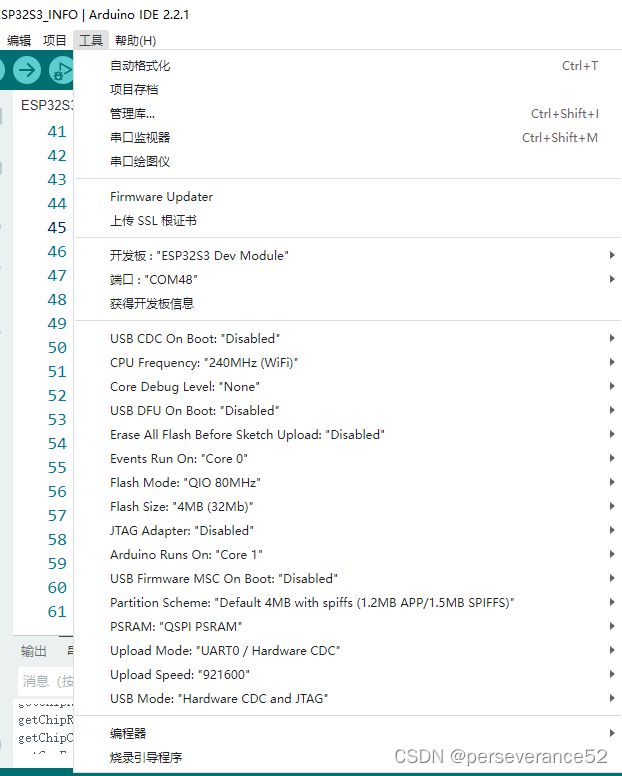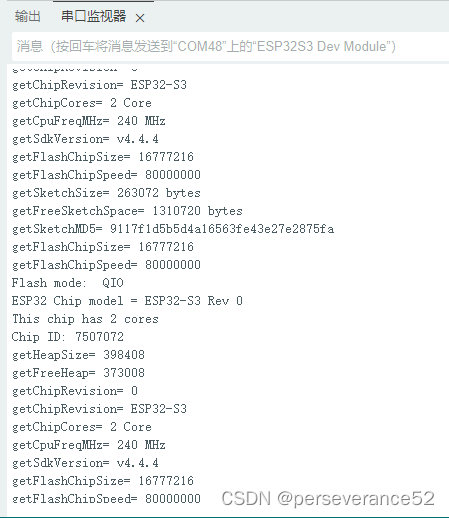ESP32S3入手体验测试
ESP32S3入手体验测试
- 所入手的型号是
YD-ESP32-S3 N16R8,该款和乐鑫官方推出的ESP32-S3-DevKitC-1配置差不多。
- 乐鑫官方介绍:ESP32-S3-DevKitC-1 v1.1
- 两者采用的模组:ESP32-S3-WROOM-1 和ESP32-S3-WROOM-1U模组对比:
- 核心模组配置都是可选。两款开发板从原理图上看,板载WS2812b灯珠所连接的芯片GPIO引脚不相同。YD-ESP32-S3板载WS2812B引脚:GPIO 48 ESP32-S3-DevKitC-1板载WS2812B引脚:GPIO38
Micropython测试
- YD ESP32S3 Micropython固件下载地址可以去官方也可以去YD官网下载,根据个人所使用的型号选择对应的固件。
-
YD固件提供地址:
http://vcc-gnd.com:8080/yd-data/YD-ESP32-S3/1-MPY-firmware/
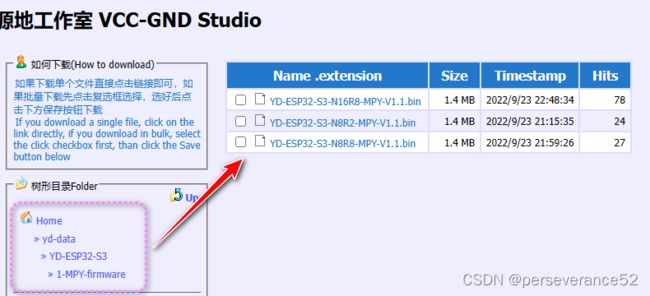
-
固件烧录采用乐鑫官方的烧录工具
flash_download_tool_3.9.5进行烧录,烧录地址:0x0,切记不要使用Thonny软件进行烧录,它默认烧录地址是0x1000。
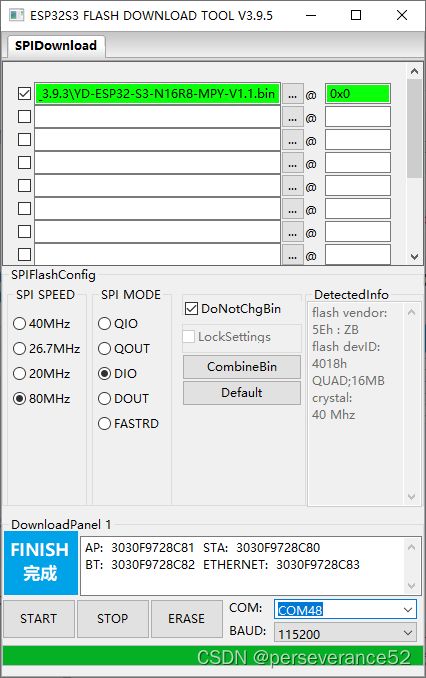
固件烧录完成后,通过Thonny软件,重启设备可以查看到打印的硬件配置信息。

-
YD提供的micropython测试代码点亮板子WS2812b灯:
http://vcc-gnd.com:8080/yd-data/YD-ESP32-S3/4-MPY-Test-Python-DEMO/
from machine import Pin
from neopixel import NeoPixel
import time
pin = Pin(48, Pin.OUT)
np = NeoPixel(pin, 1) # 一颗灯珠
np[0] = (10,0,0)
np.write()
r, g, b = np[0]
def handle_interrupt(Pin):
np[0] = (0, 0, 0)
np.write()
time.sleep_ms(150)
np[0] = (0, 0, 10)
np.write()
time.sleep_ms(150)
np[0] = (0, 0, 10)
np.write()
time.sleep_ms(150)
np[0] = (0, 0, 0)
np.write()
time.sleep_ms(150)
np[0] = (0, 10, 0)
np.write()
time.sleep_ms(150)
print("test-usr key")
p0 = Pin(0)
p0.init(p0.IN, p0.PULL_UP)
p0.irq(trigger=p0.IRQ_FALLING, handler=handle_interrupt)
- 通过micropython查看硬件配置信息:
import machine
import esp
import micropython
# 打印堆栈大小
# print("堆栈大小:", esp.get_free_heap())
print("堆栈大小:", micropython.mem_info())
# 打印flash存储空间大小
print("flash存储空间大小:", esp.flash_size())
# 读取ESP32的唯一标识符
unique_id = machine.unique_id()
# 将字节数组转换为可打印的字符串
unique_id_str = ''.join(['{:02x}'.format(byte) for byte in unique_id])
print("ESP32的唯一标识符为:", unique_id_str)
- ⚡测试时需要注意:GPIO48引脚默认是没有直接联通到GPIO48引脚的,需要自行焊接一起。
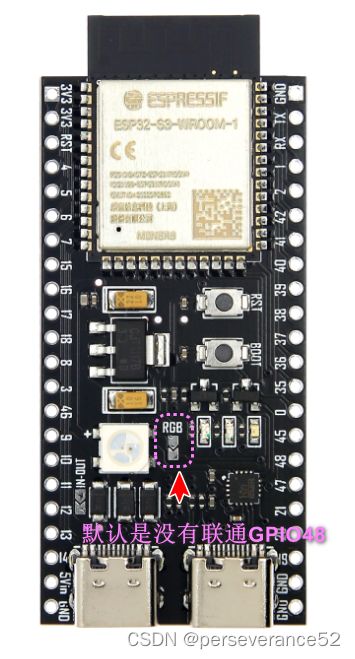
- 原图地址:
http://vcc-gnd.com:8080/yd-data/YD-ESP32-S3/5-public-YD-ESP32-S3-Hardware%20info/YD-ESP32-S3.PNG
Arduino硬件配置信息打印
/*
使用源地ESP32S3开发板:YD-ESP32-S3
兼容乐鑫官方的ESP32-S3-DevKitC-1
:YD-ESP32-S3板载WS2812B引脚:GPIO 48
ESP32-S3-DevKitC-1板载WS2812B引脚:GPIO38
*/
uint32_t chipId = 0;
void setup() {
// put your setup code here, to run once:
Serial.begin(115200);
}
void loop() {
for(int i=0; i<17; i=i+8) {
chipId |= ((ESP.getEfuseMac() >> (40 - i)) & 0xff) << i;
}
Serial.printf("ESP32 Chip model = %s Rev %d\n", ESP.getChipModel(), ESP.getChipRevision());//ESP32-S3 Rev 0
Serial.printf("This chip has %d cores\n", ESP.getChipCores());//2
Serial.print("Chip ID: "); Serial.println(chipId);// 7507072
delay(10);
Serial.printf("getHeapSize= %d \n",ESP.getHeapSize());//399848
delay(10);
Serial.printf("getFreeHeap= %d \n",ESP.getFreeHeap());// 374924
delay(10);
Serial.printf("getChipRevision= %d \n",ESP.getChipRevision()); // 0
delay(10);
Serial.printf("getChipRevision= %s \n",ESP.getChipModel()); //ESP32-S3
delay(10);
Serial.printf("getChipCores= %d Core\n",ESP.getChipCores()); // 2 Core
delay(10);
Serial.printf("getCpuFreqMHz= %d MHz\n",ESP.getCpuFreqMHz()); //240 MHz
delay(10);
Serial.printf("getSdkVersion= %s \n",ESP.getSdkVersion()); //v4.4.4
Serial.printf("getFlashChipSize= %d \n",ESP.getFlashChipSize());//16777216
Serial.printf("getFlashChipSpeed= %d \n",ESP.getFlashChipSpeed());//80000000
Serial.printf("getSketchSize= %d bytes\n",ESP.getSketchSize()); //250128
delay(10);
Serial.printf("getFreeSketchSpace= %d bytes\n",ESP.getFreeSketchSpace()); //13631488 bytes
delay(10);
Serial.printf("getSketchMD5= %s \n",ESP.getSketchMD5().c_str());//9117f1d5b5d4a16563fe43e27e2875fa
delay(10);
uint32_t flash_Size = ESP.getFlashChipSize();
Serial.printf("getFlashChipSize= %d \n",flash_Size); //16777216
delay(10);
Serial.printf("getFlashChipSpeed= %d \n",ESP.getFlashChipSpeed()); //80000000
delay(10);
FlashMode_t flash_Mode = ESP.getFlashChipMode();
Serial.printf("Flash mode: %s\n", (flash_Mode == FM_QIO ? "QIO" : flash_Mode == FM_QOUT ? "QOUT" : flash_Mode == FM_DIO ? "DIO" : flash_Mode == FM_DOUT ? "DOUT" : "UNKNOWN"));//QIO
delay(1000);
}






